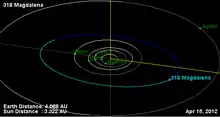318 Magdalena
Magdalena (minor planet designation: 318 Magdalena) is a main belt asteroid orbiting the Sun. It was discovered by Auguste Charlois on 24 September 1891 in Nice. It may be named for Mary Magdalene, who in legend travelled to Southern Gaul and is the patron saint of Provence.[3]
 Orbital diagram | |
| Discovery | |
|---|---|
| Discovered by | Auguste Charlois |
| Discovery date | 24 September 1891 |
| Designations | |
| (318) Magdalena | |
| Pronunciation | /mæɡdəˈliːnə/[1] |
Named after | Possibly Mary Magdalene |
| Main belt | |
| Orbital characteristics[2] | |
| Epoch 31 July 2016 (JD 2457600.5) | |
| Uncertainty parameter 0 | |
| Observation arc | 124.56 yr (45496 d) |
| Aphelion | 3.46477 AU (518.322 Gm) |
| Perihelion | 2.92120 AU (437.005 Gm) |
| 3.19298 AU (477.663 Gm) | |
| Eccentricity | 0.085119 |
| 5.71 yr (2084.0 d) | |
| 158.522° | |
| 0° 10m 21.886s / day | |
| Inclination | 10.6573° |
| 161.509° | |
| 296.737° | |
| Physical characteristics | |
| Dimensions | 85 km |
| 42.49 h (1.770 d) | |
| 9.4 | |
On April 15, 2005, UT Magdalena occulted a 10.7 mag star in the constellation Scutum for observers along a path across Australia.
Measurements made with the IRAS observatory give a diameter of 106.08 ± 0.25 km and a geometric albedo of 0.03 ± 0.01. By comparison, the MIPS photometer on the Spitzer Space Telescope gives a diameter of 105.32 ± 11.11 km and a geometric albedo of 0.03 ± 0.01.[4]
Alternative rock group The Pixies named one of their songs after the asteroid on their album Indie Cindy.[5]
References
- Noah Webster (1884) A Practical Dictionary of the English Language
- "318 Magdalena". JPL Small-Body Database. NASA/Jet Propulsion Laboratory. Retrieved 11 May 2016.
- "September 24 – Discovery of Asteroid 318 Magdalena (1891)". 24 September 2019.
- Ryan, Erin Lee; et al. (April 2012), "The Kilometer-Sized Main Belt Asteroid Population as Revealed by Spitzer", arXiv:1204.1116 [astro-ph.EP]
- Greene, Andy (27 January 2014). "Pixies' Surreal 'Magdalena' Video".
External links
- 318 Magdalena at AstDyS-2, Asteroids—Dynamic Site
- 318 Magdalena at the JPL Small-Body Database